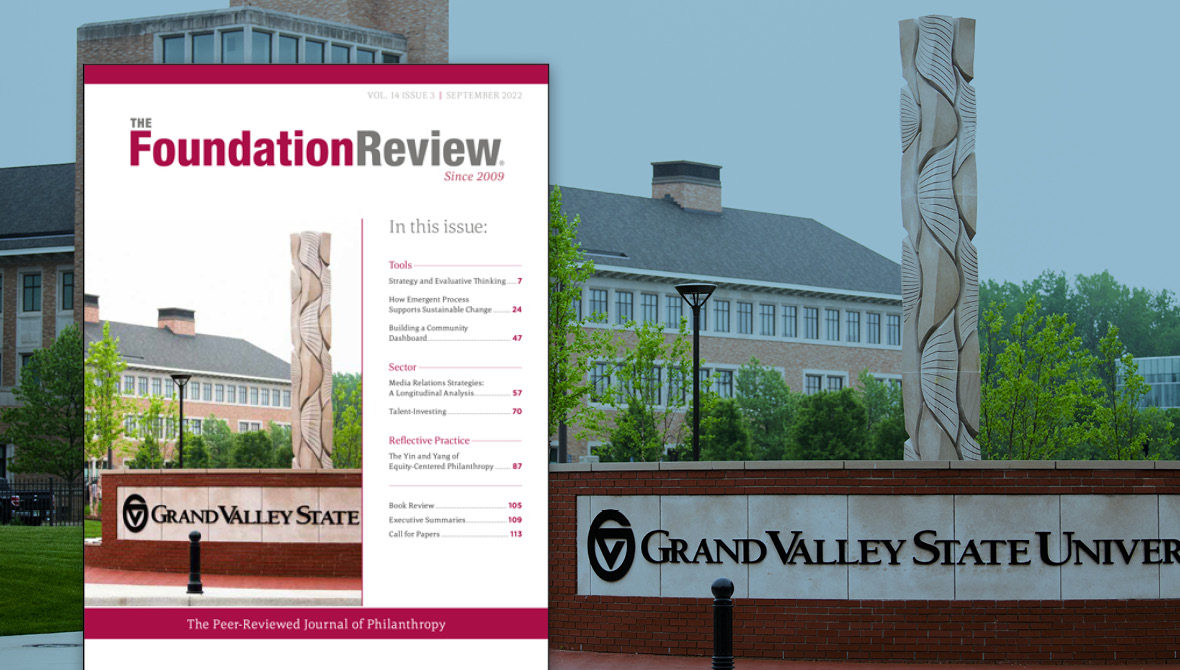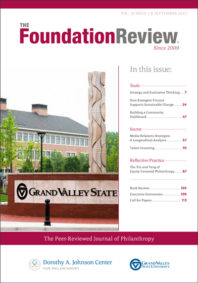Fresh Takes on Sector Change and Challenges


 This issue of The Foundation Review addresses many of the major challenges that persist across the sector, from managing strategic shifts to the use of media to human resources.
This issue of The Foundation Review addresses many of the major challenges that persist across the sector, from managing strategic shifts to the use of media to human resources.
The articles in Volume 14, Issue 3 offer fresh takes on some longstanding issues in the field of philanthropy.
Not yet a subscriber to The Foundation Review?
Start your free 90-day trial today!
In this article, Baker, Eigsti, Racine, and O’Connell describe how the Sisters of Charity Foundation of Cleveland’s Catholic Sisters Program Area used the tools of evaluation to design an inclusive, systems-based approach to manage a fundamental change in strategy. Using theory of change and stakeholder engagement, the foundation laid the groundwork for the change in strategy. Their approach may be more broadly applied by foundations rooted in legacy, history, and tradition that need to make a strategic shift.
While foundations often emphasize the importance of learning, how to actually construct learning practices for community-based work is often a challenge. Myrick, Mosher-Williams, and Zierer share the approach of the PA Heart & Soul Learning Project to learn about the experience of participants in a humanities-driven community planning pilot. Emergent learning has been proposed as a tool for whole-systems change, and this article provides interesting examples of how it can engage community members in that change.
While community dashboards have become commonplace in the philanthropic sector, they are often used primarily as a communications tool. Gregory and Gordillo describe how the Ruth Mott Foundation is putting a dashboard to use as a strategic tool. The North Flint Community Dashboard was developed as a practical tool to support decision-making, develop a common understanding of progress, and build mutual accountability with the community. The dashboard is used by program staff and potential grantees. Dashboard data will also inform the foundation’s strategic direction for the future.
Agenda-setting theory informed research by Waters, Auger, and Husted into the communications strategies of foundations. The researchers conducted content analysis of two sets of a random sample of news releases from 20 of the largest foundations in the United States. They found that foundation news releases are more tools of self-promotion than objective sources of new information that are useful to journalists. They used these results to develop a list of seven practices for foundations to use for more effective approaches to media engagement. While news releases are not the only — or even primary — media used by foundations, they are a key tool for connecting with public media. This research suggests new possibilities for exploring the multiple ways in which philanthropy can use communications to create positive social change.
While some observers have been raising alarms about the crisis in nonprofit leadership for decades, the COVID-19 pandemic has brought the issue of human resources to the fore again. Stahl explores why, despite the widely acknowledged importance of recruiting and retaining high-quality staff, funders have under-invested in human capital. Stahl describes how funders can capture and communicate the value of these “talent investments.” This is a critical point in time to consider the role of funders in supporting the people who do the work of nonprofits.
As philanthropy continues to struggle with its role in social justice and racial equity, it faces the competing imperatives of supporting and following the lead of front-line community-based groups while using its power and influence to act boldly. Easterling, McDuffee, and Gesell frame this challenge as balancing the yin and yang orientations to arrive at a comprehensive and effective approach to advancing equity. Strong working partnerships with reciprocal learning and collective strategizing can set the stage for innovative, breakthrough solutions. Naming this tension provides an important first step in being able to manage it.
This issue concludes with Haddad’s review of In Defence of Philanthropy by Beth Breeze. He offers his appreciation for her deep understanding of the field and her suggestions for practitioners.